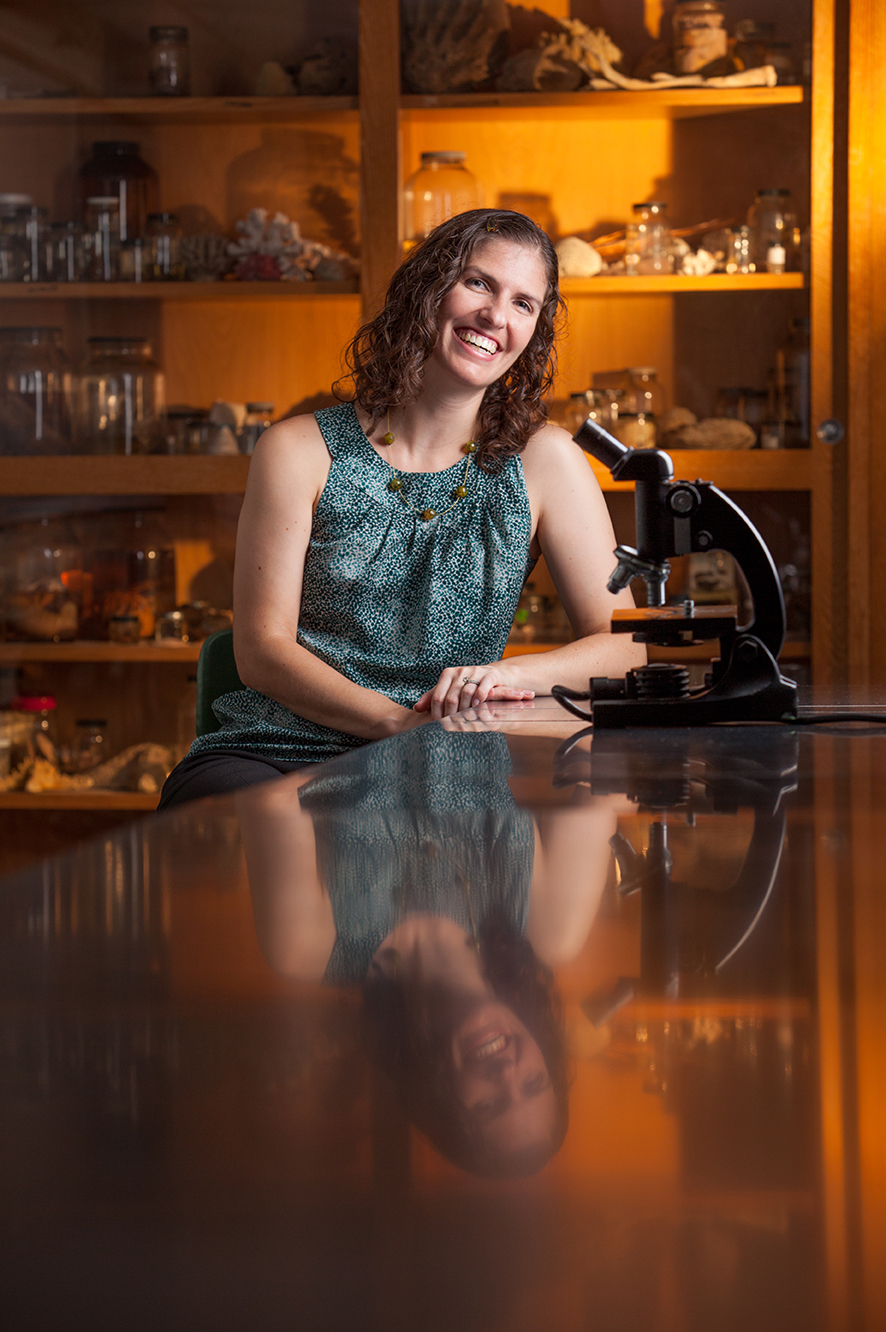Elizabeth Gleim: Ticks, A Car Named Cole and a Woman on Fire
By: Cynthia Adams | Photos By: Nancy Evelyn
Elizabeth Gleim, or “Liz” to her friends and colleagues, is an animated green-eyed brunette with shoulder-length curls. She’s a rough and tumble, dauntless researcher who has spent most of her past years either in the field or a lab. Or, more often than not, Gleim was on the open road with J-Ci, Timothy, or Cole—names of her trusty, dusty vehicles.
If she weren’t a scientist, Gleim might have considered trucking, the way she has ruggedly logged miles these past few years en route to a doctorate. Her cargo, however, was small but very troublesome for humans: ticks. Fortunately, she was more attached to her research subject than it was attached to her. (Gleim seldom ever discovered a tick on her person—but then, she knows exactly what precautions to take. Read the accompanying article, and so will you.)
Gleim may be as well known for her vehicles as she is for her research, which is saying something. In the start of 2013, Gleim moved into a modest office at Emory’s picturesque Oxford campus in Oxford, Ga., while still a University of Georgia doctoral student in the School of Forestry and Natural Resources.
“During my graduate work, I was looking at the effects of long-term prescribed burning on ticks and tick-borne pathogen prevalence—ultimately hoping to get at risks to human health,” explains Gleim. Her research is of growing interest, due to a dramatic rise in the incidence of tick-borne diseases in recent years (Lyme disease, and Rocky Mountain spotted fever, to name two familiar diseases from a long list). Did prescribed burns work? Did tick populations decrease long-term, or, in non-research terms, were they simply reduced in the short-term?
Gleim’s findings showed “that long-term prescribed fire significantly reduces tick populations.”

Gleim’s findings showed “that long-term prescribed fire significantly reduces tick populations.”
Although she graduated from UGA with her PhD in Wildlife Ecology and Management in May of 2013, Gleim returned to her old stomping grounds this past summer, the Joseph W. Jones Ecological Research Center at Ichauway, where she lived for two years performing field work during her graduate work. This past summer she worked with one of her previous graduate school advisors, Mike Conner, to create a computer model to show how tick populations were affected by burns.
“The model essentially can account for host habitat preference, tick host preference, tick lifecycle characteristics, and burn cycle intervals,” according to Gleim. They hoped the model would illustrate mechanisms behind the trends observed during her graduate work. Just as the researchers hoped, the model predicts how the burns could reduce tick populations in various land management scenarios.
Gleim is also working with an Emory undergraduate, completing pathogen testing of ticks she gathered. She had performed the large majority of testing while a doctoral student, but her student is currently focusing on testing the ticks for Panola Mountain Ehrlichia—which is yet another tickborne pathogen. One, she says, that has emerged in the last 10 years or so. And another of many pathogens transmitted by ticks that is capable of causing disease in humans.
50,000 MILES LATER…
En route to her research sites, Gleim’s various vehicles became what she jokingly calls a mobile closet. Or better yet, a mobile office. An F-150 field truck, which was white but more reddish tan due to the Georgia clay and sand roads she travelled, had a name: Timothy.
While Gleim lived at Ichauway in Newton, Ga., she zigzagged across southwest Georgia in Timothy. “So much so that the very last slide of my defense, as a ‘ha-ha,’ I (among other things) tallied how many ‘field miles’ I put on my field truck—just shy of 35,000.”
The road miles were no big deal, because Gleim was plain driven to succeed. Come weekends, she ditched Timothy for her own car, a gray Mustang named J-Ci, and commuted to Atlanta, due to the double draw of a fiancé there and a horse stabled in Decatur.
Sometimes the blues blared on the radio, but most of the time, Gleim tuned into an upbeat song and sang with gusto. She put nearly 20,000 miles on the Mustang before trouble struck.
“J-Ci was rear-ended when my now husband and I were headed out of town for our four-year anniversary—it turned out he proposed to me that weekend. I thought he seemed particularly agitated about being rear-ended, and later found out it was because the ring was in the trunk!” The engagement ring survived and so did Gleim. But she replaced J-Ci with a sturdier SUV, one that fellow researchers wouldn’t mock. Gleim bought a black Subaru Forester (naming it Cole) and kept on trucking to the tune of another 30,000 miles.
Cole was immediately introduced to the cruel vagaries of life on the road.
“I promptly put a dent in it on the very first day I owned it when I ran over a stick at Ichauway,” she says ruefully. “I also appreciated the all-wheel drive as I ran through more than a few mud puddles getting to and from my house onsite at Ichauway.” Cole was forever dusty, splattered with mud and pine sap. “And sporting hundreds of gnats and other bugs plastered onto the front grill and windshield at any given time.”
It was ironic that Gleim was about to marry a car buff, who quickly gave up on keeping Cole pristine. “During my last semester when commuting back and forth between Oxford and UGA I still had/have the Forester. I didn’t track my miles quite as well back then, but I would estimate it was approximately 700 miles per week. The dust and mud were no longer an issue, but bugs still were.”
Cole looked slightly better once Gleim left Ichauway. But, Gleim laughs, “The interior took a hit during my first semester at Oxford as it reflected my nomadic life via acting as a mobile shoe and clothing closet—work shoes/clothes, lab shoes/clothes, barn shoes/clothes, etc. I still had lab work to do, so I was driving to Athens once or twice a week to do my research,” she says matter-of-factly. Gleim actually defended her dissertation on the effects of long-term prescribed burning on tick and tick-borne pathogen dynamics while also responsible for lab management at Oxford College of Emory University and observing the class she would soon be teaching. All of this was achieved “while finishing lab work and writing my dissertation and finally, defending my dissertation.”
But Gleim felt the Oxford opportunity was a stroke of sheer good fortune. “I got really lucky,” she marvels.
No accident of fate, disagrees Lindsay Boring, who directs the Joseph W. Jones Ecological Research Center at Ichauway. Prior to working as a visiting scientist there last summer, Gleim spent nearly two years at Ichauway as a doctoral student. Boring came to know Gleim well.
He also was in the audience observing her performance at a UGA event the prior year. “She had one of the lead finishes at the 3MT competition,” recalls Boring. “She is a very articulate speaker and had a pretty charismatic doctoral project with that intersecting ecosystem health/human health theme.”

FACT 1: PROTECT YOURSELF In order to avoid a tick-borne disease, the most important thing is checking yourself frequently while you’re outdoors, performing a full body check immediately upon returning. “Because at the end of the day there are always ticks that get through those defenses.” Gleim stresses prompt, thorough and systematic self-examination.
The timed competition is a forum for graduate students to pitch their thesis research to a general audience. The idea helps researchers clarify their work, and is a popular way to refine their public presentation skills. But there was more than research for Gleim to manage. Cramming her personal life into the mix, Gleim was also planning her wedding, which was set for spring 2013. A born multi-tasker, Gleim kept pace with a crazily busy calendar. She defended her dissertation on March 28, celebrated her birthday on April 8, and was married April 21.
The couple married in Charleston, S.C. where she probably made one of the oddest requests that her caterer had ever received…she wanted a small tick frosted onto her otherwise traditional cake. At the wedding reception, they danced to Jordin Spark’s “Worth the Wait.” As she says, “I grew up on rhythm and blues.” A bit sheepishly, she adds, “I like Mariah Carey, Destiny’s Child, and Taylor Swift….and when I was alone doing field work, I used to sing.”
After a honeymoon trip to Jamaica, Gleim was back in Georgia to tie up loose ends and pick up a sheepskin on May 10, 2013—her doctoral degree from UGA. She was now a true Georgia Dawg (almost a Double Dawg, given she also earned a Teaching Certificate,) a PhD, and newly married.
So it surprises no one that Gleim is a big proponent of controlled burns, as in fire. She herself is on fire to achieve life goals as quickly as possible. All of which is more than a little ironic for a scientist who insists she always had to work hard. “It helps me understand where my students are getting hung up,” she says.
A year and a half later, Gleim strides through Oxford hallways taking long, purposeful, coltishly energetic steps. No surprise—she is a horsewoman. Gleim’s an equestrienne who did pre-veterinary undergraduate work at Hollins University, a school chosen as a place where she could also board her horse. “I jumped, and showed in the hunters,” she says.
Gleim retains a horsewoman’s physical poise and strong posture. When asked if there’s any material thing she is particularly attached to in her life, she reflects only a minute before answering, “My chaps.”
And when asked if there is anything unusual about her interests, she lights up. Gleim was a board member of the Little Creek Farm Conservancy in Decatur from 2011-2013 and remains an active member of the organization. “It is the only publicly owned and operated horse farm in the metro Atlanta area.” When she spent the summer of 2014 doing visiting research at Ichauway, people there had no idea about her work with the conservancy.
Her life is still enhanced by a love of horses. The horses boarded at Little Creek Farm allow contact with the “rare elements of grace, beauty, spirit, and fire,” according to the conservancy’s website.
Actually, the phrase could easily be applied to Gleim.

PANOLA MOUNTAIN EHRLICHIA Gleim is also working with a student to complete pathogen testing of ticks she had gathered while a graduate student. She had performed the large majority of testing while a doctoral students, but her student is currently focusing on testing the ticks for Panola Mountain Ehrlichia– yet another tick-borne pathogen.
LIGHTING INTELLECTUAL AND REAL FIRES
Gleim keeps a hunter orange ball cap from her graduate work at the Joseph W. Jones Ecological Research Center, and a yellow sign emblazoned “Tick Crossing” on the bulletin board in the science building at Oxford.
Colleagues pop in and out, saying hello and checking in with Gleim. She loves research, but no more than she loves teaching. We discuss what it was like to teach her first day (“Nervous,” she laughs. “…So nervous…”) Her mom taught briefly, but became a stay-at-home mother. Even so, a love of education is something they shared.
What lit her intellectual fire?
“It was a professor at Hollins,” says Gleim. She was 20 years old, in pre-veterinary studies at Hollins, and had performed a few veterinary internships. “I loved the (veterinary) work, but didn’t necessarily want the lifestyle. Meanwhile, I had taken a microbiology class and realized I enjoyed public health and disease. Those made me think about the research side of things. I was becoming more interested in research.”
That was when a Hollins professor suggested Gleim consider teaching at the college level. “I thought, that does sound neat. This light bulb went off….”
So Gleim explains how she knew she would become an educator before she knew what she was going to study.
“I decided early on that I was going to take a year off to work and explore what my options were, and took a position at the CDC.” Gleim accepted a year-long fellowship at the Centers for Disease Control and Prevention, or CDC, in the division of parasitic diseases within the recreational water laboratory.
Upon completing her year-long fellowship, Gleim accepted a position in the diagnostic laboratory in the same division at CDC. But she realized that while she enjoyed molecular disease work, there was something missing.
“During two years off (from studies), I was consciously thinking about whether I was going to do that all my life. But I missed field work and ecology although I had enjoyed the work with the CDC.”
Gleim made the ultimate decision to apply to UGA’s ecology program.
Then…“I was actually just talking to my boss at the CDC one day, and discussed my dilemma about studying ecology or disease. And she said, ‘Liz, have you ever heard of Michael Yabsley?’” She had not.
“Then, my boss said, ‘He studies disease ecology.” The statement provoked a research epiphany for Gleim. “I realized that was what I’d been looking for.”
This was the spring of 2008. Gleim’s boss at the CDC put her in touch with Yabsley. But the timing was not the best.
“He said, ‘Obviously it’s a little late this year, but I may have an unexpected opening on one project. But if that project doesn’t interest you, I will help you find one in 2009.”
Yabsley made good on his offer. Shortly after their chat, he notified Liz that, in fact, the unexpected opening was a go. The project concerned the long-term effects of prescribed burns for ticks. Gleim didn’t hesitate to join the project that fall.
“There was a push to re-introduce prescribed burns back into our forests in the 1960s. Around that same time, we were trying to find benefits to burning— maybe it reduced tick populations. In the 70s and 80s, there was a flurry of studies on the topic and even today studies still occur, yet they have had differing results.” There was an immediate decrease in ticks after burns, but sometimes rebounding populations, she explains.
“When we started looking at the question, the first was, why these different results? A lot of the studies were not accounting for many variables…and/or they weren’t simulating real world regimes. We basically put our project together to account for all those variables and look at areas already managed by fires and look at what the tick populations were doing.”
Gleim says she never had to get past the frequent tick-ick! factor.
“Ticks never really bothered me; they have to crawl on you. So, they aren’t as elusive as people might think they are.”
THE JOYS OF TEACHING
Students were once expected to absorb how to become a good teacher by observation and accrued experience. Now there is methodology and there is a training protocol. Gleim credits a UGA teaching certificate earned through the Graduate School, the Interdisciplinary Certificate in University Teaching, for playing a strong role in her teaching skills.
“While at UGA, I felt I could see this evolution, from this culture where it was assumed that an intelligent person would just know how to teach, to seeing the pedagogy and the science and methods behind it,” she says. “And it was so exciting to see some importance attached to the art of teaching.” A professor led her to the certificate program.
“When I first got to UGA, I randomly got placed to be a teaching assistant with John Maerz. I told him I wanted to teach, and he said, ‘You need to do the teaching certificate that UGA offers.’”
During the process, Gleim says the teaching certificate went from “being a program many didn’t know about to one that became well known.”
In riding terms, Gleim had cleared all hurdles and was seated comfortably. From the first day in her Oxford classroom, she felt admittedly nervous but oh-so-happy.
She was hitting her stride, as a scientist and educator.

FACT 2: ALL HUMAN-BITING TICKS HAVE THREE LIFE STAGES; they begin with a larval stage; then, the nymphal stage and, lastly, the adult stage. A tick can enlarge its size 20-50 fold when engorged with blood, making them hard to identify. Every tick species is capable of vectoring different pathogens.

Long Leaf pines at Joseph W. Jones Ecological Research Center at Ichauway
FACT 3:
DISEASES TRANSMITTED BY TICKS that are most commonly reported in the U.S. are Rocky Mountain spotted fever and ehrlichiosis. “Many of these start with non-specifi c fl u-like symptoms,” says Gleim. “A lot of them go undiagnosed.” Some of the key ones: Lyme disease, Rocky Mountain spotted fever; human granulocytic anaplasmosis (HGA), human monocytic ehrlichiosis (HME); Ehrlichia ewingii ehrlichiosis, Rickettsia parkeri rickettsiosis; Southern tick-associated rash illness (STARI); and, babesiosis.
FACT 4:
TO REMOVE AN ATTACHED TICK, Gleim advises that you don’t attempt to burn it nor drown it in alcohol or petroleum jelly as these things can do more harm than good. “Instead, use fine-tipped tweezers to grasp the tick as close to the skin as possible and pull directly out without twisting. It is wise to save the tick for several weeks in case of disease development. One can preserve a tick by storing it in a small amount of rubbing alcohol or alternatively freeze the tick in a Ziploc bag. Should you develop a fever, rash, and/or flu-like symptoms within several weeks of removing the tick, contact your doctor.”
WHAT IS MOST SURPRISING ABOUT TICKS? “I think that most people are surprised to find out that those tiny ticks they find on themselves are not necessarily a different species of tick from the bigger ones but rather, may possibly be a different life stage of the same species.”
People are also surprised to learn “… that such a low percentage of ticks are positive for a pathogen,” says Gleim. “And the amount of time it takes to transmit them.”
FACT 5:
MOST HUMAN TICK-BORNE PATHOGENS REQUIRE THAT THE TICK BE ATTACHED FOR 24-48 HOURS FOR TRANSMISSION. Pathogens can be transmitted in eight hours or less. Thus, prompt removal is key. Ticks carry pathogens at a low prevalence. Generally speaking, only 1-5% of ticks carry any particular pathogen, so the chance that a tick attached to you has something is low.
FACT 6:
A NUMBER OF TICKS CAUSE DISEASE IN HUMANS. The lone star tick is the most common in the Southeast and is known for being an extremely aggressive biting tick. It is nondiscriminatory about the host it seeks out and is prolific. Like other ticks, the lone star tick is very cyclical in its activity. Their lifestages are active from spring through the fall, and not only during summer.
- For more information about tick-borne diseases, see the CDC website at http://www.cdc.gov/ticks/ or visit: http://extension.uga.edu/publications/detail.cfm?number=C937
- For more information on prescribed burns, see the website for The Coalition of Prescribed Fire Councils at http://www.prescribedfire.net
- For more information on Michael Yabsley’s work at UGA and the Southeastern Cooperative Wildlife Study: http://yabsleyugalab.weebly.com and http://vet.uga.edu/scwds
- For more information on the Joseph W. Jones Ecological Research Center and the Warnell School of Forestry and Natural Resources: http://www.jonesctr.org and http://www.warnell.uga.edu/
- For more information on Elizabeth Gleim’s research: http://sites.google.com/site/elizabethgleim/home








